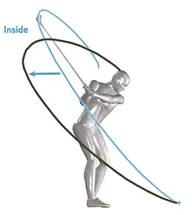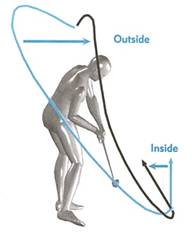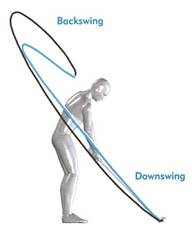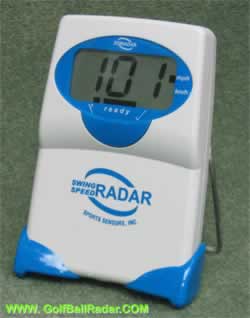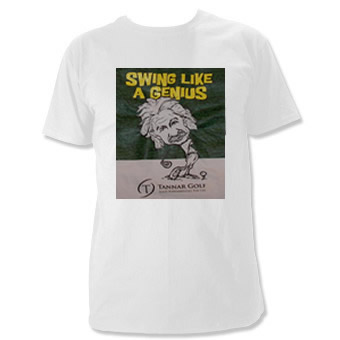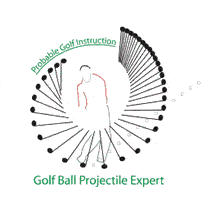
|
|
|
Tempo, Timing & Rhythm --Backswing/Downswing Ratio
It's been determined that for the body to efficiently swing the golf club, there is an ideal Backswing/Downswing tempo ratio. John Novosel was one of the first to realize this after analyzing the tempos of many professional golfers. He found that all good professionals have a 3 to 1 ratio for Backswing/Downswing Tempos, meaning that the Backswing takes 3 times as long as the Downswing. Although players swing with different total tempo times, the ratio is the same. Some take as short as 0.80 second from takeaway to impact, while others take as long as 1.20 seconds. From a physics standpoint, the golf swing is a double pendulum motion, which involves a hinging of the wrists (also know as wrist cock). It is this double pendulum motion that creates the high club speed necessary to hit the golf ball a long ways. Compare the double pendulum golf swing animation below left to Tiger's slow motion downswing. The animation repeats, so, start and stop Tiger's video at different stages. The animation runs more quickly than Tiger's slow motion swing.
There have also been quite a few biomechanics studies of the golf swing. One in particular, " Towards a Biomechanical Understanding of Tempo in the Golf Swing" by Grober and Cholewicki of Yale University found a good model for the golf swing. They found: " ... the tempo of the golf swing of professional golfers exhibits remarkable uniformity in 1) the absolute time scale, 2) the ratio of backswing time to downswing time and 3) the invariance of these times as a function of the length of the swing. These observations suggest that professional golfers have at the core of their golf swing a biomechanical clock." They found that a realistic model for a golf swing is like a torsion spring with low stiffness being wound up and then released. The arms and club rotate around the body, as it coils. The body then uncoils pulling the arms and club with it. Grober and Cholewicki confirmed from a theoretical biomechanical level, that for such a system to work efficiently, the backswing coil lasts about 3 times longer than the downswing coil. This confirms Novosel's findings. In summary, Grober & Gholewicki found: 1. A system like the golfer swinging a club naturally will take about 0.75 seconds for the backswing, regardless of the length of the backswing. 2. The downswing of such a system will take about 0.25 seconds. 3. Thus the ratio of backswing to downswing is 3 to 1, regardless of the length of the swing. As more evidence, review the information below from one of my earlier newsletters. Take a look at this slow motion video of Tiger hitting an iron at the 2007 PGA. I grabbed a stopwatch and timed the various parts of the swing.
In slow motion (thus time measured will be much longer than real time), here are the times for Tiger: From takeaway to impact = 21.4 Transition Period = 6.6 I measured the transition period to be from when Tiger's hands are level with his head from backswing to downswing. The ratio of his transition period to total (backswing-forwardswing) is 6.6 to 21.4 which is about 30%. He spends almost 1/3 of the time changing direction at the top of the swing. Likewise, take a look at Tom Watson's swing.
From takeaway to impact = 9.7 Transition Period = 3.5 Note that the times for Watson's are shorter due to the slow motion video being at a different rate. The ratio of his transition period to total is 3.5 to 9.7 which is about 36%, again measuring his hands from level with his head. Usually, when a player begins to hit the ball more poorly than normal, it's because they disrupt tempo ratio of Backswing/Downswing, usually getting a little quick during the transition phase. Their rhythm is off along with the timing of the proper sequences of the downswing. You'll find that the audio tracks offere by Tour Tempo below will help you get back on track quickly. It's kind of like practicing the play of a musical instrument using a metronome to help with the timing and the rhythm.
Have you ever heard the tip "wait for the club at the top of the swing"? This tip is referring to taking enough time during the transition period to change the direction of the club. You must do so slowly, so that the large muscles of the body have time to lead the downswing.
Ideally, the club travels along approximately the same plane on the way down as on the up. A number of very good golfers actually have a slightly flatter downswing plane. They achieve this through a strong lower body rotation which drops the arms and club down.
On the other hand, many amateur golfers initiate the downswing with the arms and upper body, which moves the arms and club more outwards, creating and outside-to-inside swing path.
This move also puts the club in a position from which it is hard to release (close the club face), thus the face is left open. The result is a slice. Review your weight transfer lesson here: Golf Swing Weight Transfer -- The Athletic Move If one initiates the downswing well with a strong lower body rotation, the club will follow a swing plane very close to the backswing swing plane. The club path will be from inside the target line to along the target line to inside the target line.
Go to this page to learn a method of aligning using an intermediate target. CLICK HERE To learn more about Intermediate Focus Golf, CLICK HERE
Want to view other lessons in this series thus far. Click on the link below. Lesson #1: Golf Grip -- The Connection Lesson #2: Golf Stance & Set-up -- The Foundation Lesson #3: Golf Swing Plane -- The Swing Slot Lesson #4: Golf Swing Weight Transfer -- The Athletic Move Lesson #5: Golf Swing BackSwing -- The Takeaway & Coil Lesson #6: Golf Swing DownSwing -- Maintain Angles & Transition Period Lesson #7: Tempo Timing Rhythm -- Backswing/Downswing Ratio
©Probable Golf Instruction, Ken Tannar 2001-2015. All Rights Reserved. Langley, B.C. V2Y 2G4 CanadaPhone: 604-309-7030 FAX: to fax, email an attachment probablegolf@yahoo.ca or golfexpert@probablegolfinstruction.com |
| GOLF ASSISTANTS |
|
Golf Trip Pairing CalculatorPlanning a golf trip with some friends/family? Trying to sort out the foursomes so people don't play too often with others? Order your ready made Spreadsheet. Type in the names, print out the groupings. Minimize repeat pairings.
Wind Caddy will advise you on aim, distance and club so that you can play the wind successfully. It takes the guess work out of club selection. New option to enter custom distances for each club. The algorithm will make a club suggestion accordingly. Use the right club in every condition!
|
|
|
| GOLF NEWS |
Golf Putting Green Reading Glasses |
| GOLF NEWSLETTER |
Statistics
·Putting
·Long Balls
·Games
·Handicap
·Scoring
·Shot Patterns
·Tournaments
·Tours
Pro Shop
·Ball Marker Engraved
·Books
·CDs & DVDs
·Green Reader
·Impact Labels
·Laser Rangefinder
·Longer Drives
·Products
·Teaching Aids
|
|
| GOLF POLL |
The 19th Hole
·Advertising
·Ask the Golf Expert
·Consultation/Litigation
·FAQs
·Golf Blog
·Golf Draws
·Links
·Science of Golf
·Tell a Friend
·Testimonials
·

Golf Ball Finder Glasses
Find all your errant golf balls and many more!
| GOLF TIPS |
How to play:
|

